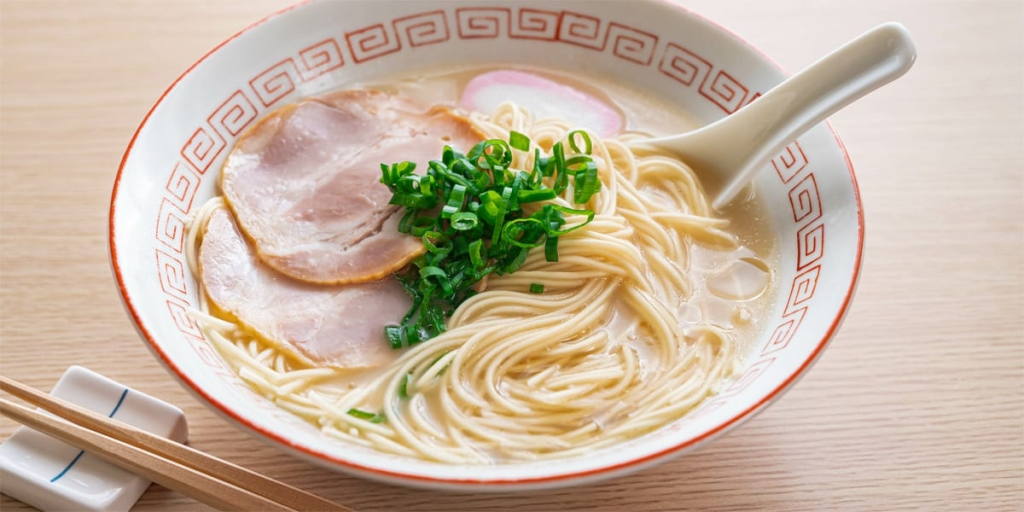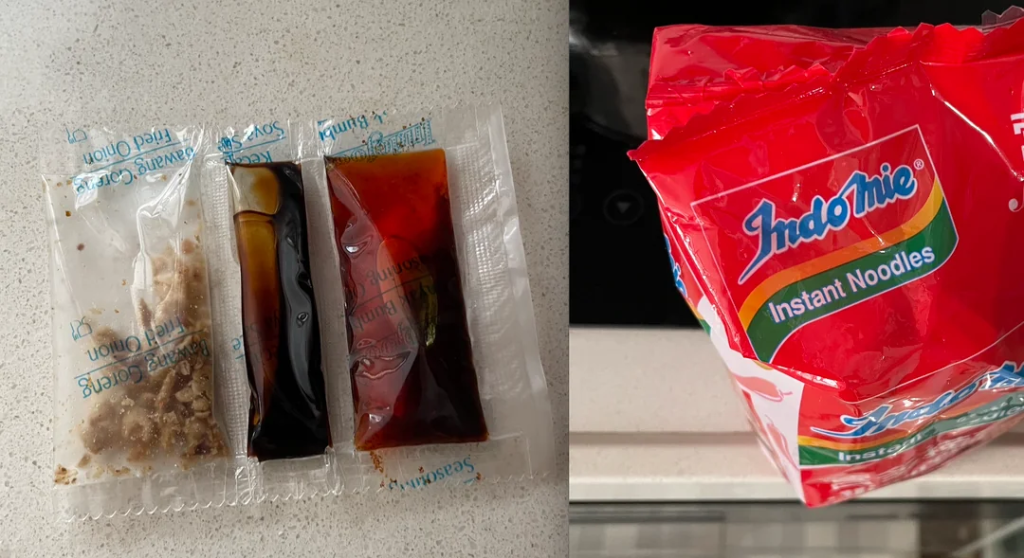Indomie instant noodles now occupies the same position on the Nigerian menu as Fufu, yam, Egusi and jollof. Here’s the story of how the Indonesian import earned its place as a Nigerian staple.

A Queue Of Hungry People Inspires Japan’s Greatest Invention
Instant noodles, as we know and eat it, were invented in 1958 by Taiwan-born Japanese inventor and businessman, Momofuku Ando. After the end of the Second World War, much of Japan was left in rubble from Allied bombing campaigns during the war. Those who had survived the war were almost starving. Hungry people littered the streets. People slumped and died from starvation and malnutrition.
One day, Ando passed by a black market area near Osaka Station. He caught sight of people in a long queue in the cold at a makeshift stall waiting for a bowl of ramen noodles. The sight produced a powerful effect on Ando. It reminded of how much Japanese people loved ramen as well as provided evidence of an enormous demand for the product. At the time, the government encouraged their people to eat bread and biscuits made from surplus American wheat. And Ando wondered: why not ramen?

Ando resolved to invent a “Ramen that can be quickly prepared and eaten at home with only hot water.” In 1957, in a shed he built in the backyard of his home, the 48-year old Ando began researching his new ramen. He worked nonstop and alone. A year later in 1958, he offered the world’s first instant noodles.
Originally from China, Ramen was introduced into Japan in the 1859 and is now a cultural phenomenon in Japan. Traditional ramen noodles are wheat noodles made separately and served in a soups with slices of meat or tofu on top. But Ando’s Chikin Ramen was ready to eat in just two minutes requiring only the addition of hot water.
He invented a way of moistening the noodles, drying and then dehydrating them by flash-frying. For mass appeal, he also flavoured the noodles with chicken soup, inventing what is now repeatedly voted Japan’s most successful invention ahead of Walkman, bullet train and karaoke!

Indomie: From Indonesia to Nigeria
In 1958 Japan, Ando’s instant noodles, sold as Chikin Ramen, were still extremely pricey, selling 6X the price of normal ramen. In 1959, as part of efforts to support Japan, Mitsubishi Corp., Japan’s top general trading house, helped promote the product. Their marketing support would lead to growth in sales and popularity not only in Japan but across Asia, including Indonesia from where they would reach Nigeria and become as popular.
The word ‘Indomie’ itself tells of its origins. The “Indo” in it is for “Indonesia” while “mie”, is an older spelling of the Indonesian word for noodles, “mi.” In 1972, three years after its introduction from Japan, PT Sanmaru Food Manufacturing Co. Ltd. offered the first Indomie instant noodle with chicken flavour.
A decade later, in 1982, Indomie launched Mi Goreng, the first fried noodles variant that was inspired by Indonesian street food. Indomie Mi Goreng (or friend noodles) became an instant hit, essentially reshaping the instant noodles market and making Indomie an industry leader.
Through the 80s: Coming and Setting Up
By the late 80s, Indomie already had a strong market hold in Southeast Asian markets and the Middle East. They however, sought for new markets with potential for long-term growth. In a trade conference in Singapore in 1985, Indomie executives met Nigerian business delegates who were in search of foreign investments in their country.
At the time, Nigeria was under military rule and was thus, politically unstable. This discouraged other multinationals from venturing here to do business. But from Indomie’s view, the nation was however, undergoing vast transformations across its demography. The population was growing and urbanization was happening at a breakneck pace. This presented an opportunity.
In 1986, Babangida’s government adopted the Structural Adjustment Program (SAP) that created hardship for the citizenry. The program, however, emphasized local manufacturing and reduction of imports. This also presented another opportunity for a company known for establishing its permanent presence by local manufacturing.

Into the 90s: Cracking the Code
After two years of researching their new market, Indomie launched in 1988, targeting select neighborhoods in Lagos with middle-class and expatriate families who were receptive to the product. Dufil provided market research that further helped Indomie iterate their efforts towards reaching a broader base. For instance, they held taste-testing sessions in different neighborhoods and gathered feedback regarding flavor preferences to cooking habits that would prove vital.
Into the 90s, they launched in other cities like Ibadan and Port Harcourt. At this time, import costs and currency fluctuations became a challenge for keeping the price of their product. As a response, in 1993, plans were made to start making the noodles locally and in 95, their first manufacturing plant became operational at Ota, Ogun State.
The plant hummed churned out 250,000 packets daily. This allowed costs to drop allowing Indomie cement its commitment. In 1996, they began offering “Special Pack”, a small, cheap pack that became hit with students. In 1998, they introduced new flavours like onion chicken that tuned into local states.

Into the 2000s
The 2000s saw Indomie explode. Local production allowed them flood markets with affordable packs. Their “Route-to-Market” program, launched in 1997, hit its stride, arming distributors with branded vans and training. Their rural hubs and “Market Storm” teams took their noodles into villages.
By 2005, 60% of their manufacturing materials came from Nigerian farms; this helped slash import reliance and keep their prices low. Their “Indomie Fan Club” hooked kids with school events, while their 2004’s “Indomie Believer” kiosks turned street vendors into brand ambassadors. Into the decade, digital buzz grew, with their recipes going viral online. This would draw them their first competitors. One of them, Golden Crown, was unable to match Indomie’s reach or place in the culture and flopped quickly.

2010s: Crushing the Competition
By 2019, Indomie controlled up to 74% of the market, producing an immense 1.7 billion packs yearly. Giants like Nissin and Dangote Noodles tried to take a market share and failed. Nissin’s premium play flopped and Dangote couldn’t crack the taste or loyalty Indomie had built over the years. In 2017, Dangote conceded defeat and sold its noddle business to Indomie.
10 factories across Nigeria, a vast distribution web and roots embedded in Nigeria’s food culture has made Indomie untouchable. Their taglines have seeped into slang and featured in songs and films. An ecosystem of suppliers and vendors thrived around them, serving as proof that Indomie was not just a product, but Nigeria’s very own. Many Nigerians remain unaware of its Indonesian origins. Even if they did, they would not care.
Today, the name Indomie has become shorthand for noodles. There’s just Indomie.
More Nigerian Business Histories:
Kingsway Stores: What Happened to Nigeria’s First Department Store: Journey through the golden days of Kingsway Stores and discover how this iconic retailer shaped Nigeria’s shopping culture—and why its memory still lingers today.
Unilever: The Story of Nigeria’s Ancestor Company: Read the story of Unilever Nigeria, the 100-year company that spawned Nigeria’s most iconic products: Omo, Knorr, Lux, etc.












